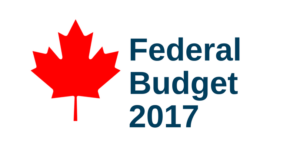By HighView Financial on March 28, 2017
 On March 22nd, 2017 the Trudeau Liberal Government presented their second Federal Budget. Compared to their first budget, which included significant increases in taxation and program stimulus, this budget provided relatively small changes to certain programs and positioned the Government for uncertain outcomes in the United States as well as with the domestic economy.
On March 22nd, 2017 the Trudeau Liberal Government presented their second Federal Budget. Compared to their first budget, which included significant increases in taxation and program stimulus, this budget provided relatively small changes to certain programs and positioned the Government for uncertain outcomes in the United States as well as with the domestic economy.
Many are coining this to be a “wait and see” budget, as our Federal Government is constrained by a low-growth economy and global unknowns that have forced them to be prudent with policy. Also, the commentary from industry pundits is more about what was not in the budget, opposed to what was actually tabled.
For example, policy changes of interest that did not make the budget:
- No changes to corporate or personal income tax rates
- No changes to the small business deduction threshold
- No changes to capital gains taxation (an anticipated change from 50% to 66.67% or 75%)
- No changes to the use of Private Corporations for tax planning
There is no forecast for a balanced budget in the near future, as the Liberals project a deficit for 2017-2018 of $28.5 billion, with a modest decline to $18.8 billion by 2021-2022. Although this result is contrary to the Liberals’ promise to eliminate the deficit, they have changed their focus to a debt to GDP ratio of 31% over the next five years as a controlling mechanism.
Key Highlights in the Budget
- $523.9 million over five years to prevent tax evasion and improve compliance. The Government anticipates a return on their investment of $2.5 billion over these five years.
- $11.2 billion over 10 years to invest in cities and provinces across Canada for affordable housing as part of the Government’s infrastructure program.
- $7 billion over 10 years for Canadian families, including new subsidized daycare facilities, extended parental leave, and a new program allowing expectant mothers to claim maternity benefits early.
- $400 million over three years via the Business Development Bank to allow more venture capital available to Canadian entrepreneurs.
- $395.5 million over three years for the youth employment strategy.
- A new national database defined as the Housing Statistics Framework, to track details on the purchasing and selling of residential real estate, as well as demographic and financing information and foreign ownership percentages.
- An “innovation and skills plan” to boost six high-tech growth sectors: Digital Industries, Health/Bio-Sciences, Clean Technology, Clean Resources, Advanced Manufacturing, and Advanced Agri-food.
Important Future Considerations
Tax Planning Using Private Corporations
The Government will be completing a “review” in the near future on the use of Private Corporations for individual tax planning.
In the 2017 budget, it is mentioned that strategies using private corporations, which can result in a variety of tax reduction strategies for individuals and families, are not available to other Canadians. Therefore, the idea of Private Corporations, and their use of the following strategies are under scrutiny:
Sprinkling income using private corporations, which can reduce income taxes by causing income that would otherwise be realized by an individual facing a high personal income tax rate to instead be realized (e.g., via dividends or capital gains) by family members who are subject to lower personal tax rates (or who may not be taxable at all).
Holding a passive investment portfolio inside a private corporation, which may be financially advantageous for owners of private corporations compared to otherwise similar investors. This is mainly due to the fact that corporate income tax rates, which are generally much lower than personal rates, facilitate accumulation of earnings that can be invested in a passive portfolio.
Converting a private corporation’s regular income into capital gains, which can reduce income taxes by taking advantage of the lower tax rates on capital gains. Income is normally paid out of a private corporation in the form of salary or dividends to the principals, who are taxed at the recipient’s personal income tax rate (subject to a tax credit for dividends reflecting the corporate tax presumed to have been paid). In contrast, only one-half of capital gains are included in income, resulting in a significantly lower tax rate on income that is converted from dividends to capital gains.
A number of measures have been put in place over the years to limit the scope of some of these planning arrangements, but such measures have not always been fully effective. The Government intends to release a paper in the coming months setting out the nature of these issues in more detail as well as proposed policy responses.
At HighView, we are focused on how the budget will impact our clients, foundations, and the Canadian economy as a whole. We expect to see more substantial changes as 2017 rolls on, and as such we will continue to update our readers with our opinions on newly proposed strategies.
HighView is an experienced investment counselling firm for Canadian families and foundations. We would be happy to discuss our goals-based investment approach with you.
Click here to watch our videos addressing a variety of investment topics for Canadians.
You may also be interested in:
- What Is Wealth Stewardship?
- Integrated Wealth Management Advice for Affluent Canadian Families – A Different Approach
- Understanding Pool Funds [Video]
- Understanding Wealth Stewardship - August 4, 2022
- Reaching a Successful Transition of Family Wealth - May 12, 2022
- The Obstacles in Creating Sustainable Wealth - April 7, 2022




